Service Directory
Use the Service Directory's flexible search engine to drill into relevant information and perform actions on services
The Service Directory is a searchable, high-level aggregate view of all PagerDuty services in your organization, and their corresponding owners. It allows everyone to search for the services they support and learn more about other services in their organization. From the Service Directory, you can learn more about individual services, adjust settings, and review Service Standards.
Required User Permissions
All users can view the Service Directory. The displayed results may vary, however, depending on a user’s permissions. Only users who have permission to create or edit a service can take those actions from the Service Directory.
Navigate to the Service Directory
In the PagerDuty web app, navigate to Services Service Directory.
The Service Directory provides the following information about services:
- Service incident state
- No open incidents: There are currently no open incidents on the service.
- Awaiting response: There are one or more open incidents on the service with a triggered status.
- Response in progress: There are one or more open incidents on the service with an acknowledged status
- Disabled: The service is currently disabled and will not trigger any new incidents.
- Maintenance: The service is currently in a Maintenance Window.
- Service name and description
- Team
- A service's Team is determined by the Team its escalation policy is associated with.
- If your account does not have Teams, the associated Escalation Policy will be displayed.
- On Call Now
- The user who is currently on call for the service.
- If there are three or more users on call, this field will display the total number. You can click a service's name to view its details page and the full list of current on-call users.
- If no one is currently on call for the service, this information will be highlighted so that you can easily identify gaps in on-call coverage.
- Last incident
- The date and time of the last incident that was triggered on the service. You can click the link to quickly access the details for that last incident.
- Open incidents
- The current number of triggered and acknowledged incidents on the service.
- Standards met
- The number of Service Standards that the service meets, displayed as a fraction, e.g., 7/10.
Search
With the Services tab selected, you can search for a service by name or description. By default, results are ordered by highest relevance to lowest.
If services do not populate, check to see if you have any filters applied. You may want to adjust your Team filter to All Teams and your incident filter to Any time. If you still do not see any results, you may need to contact your PagerDuty administrator to confirm that you have the correct permissions to view the service(s) in question.
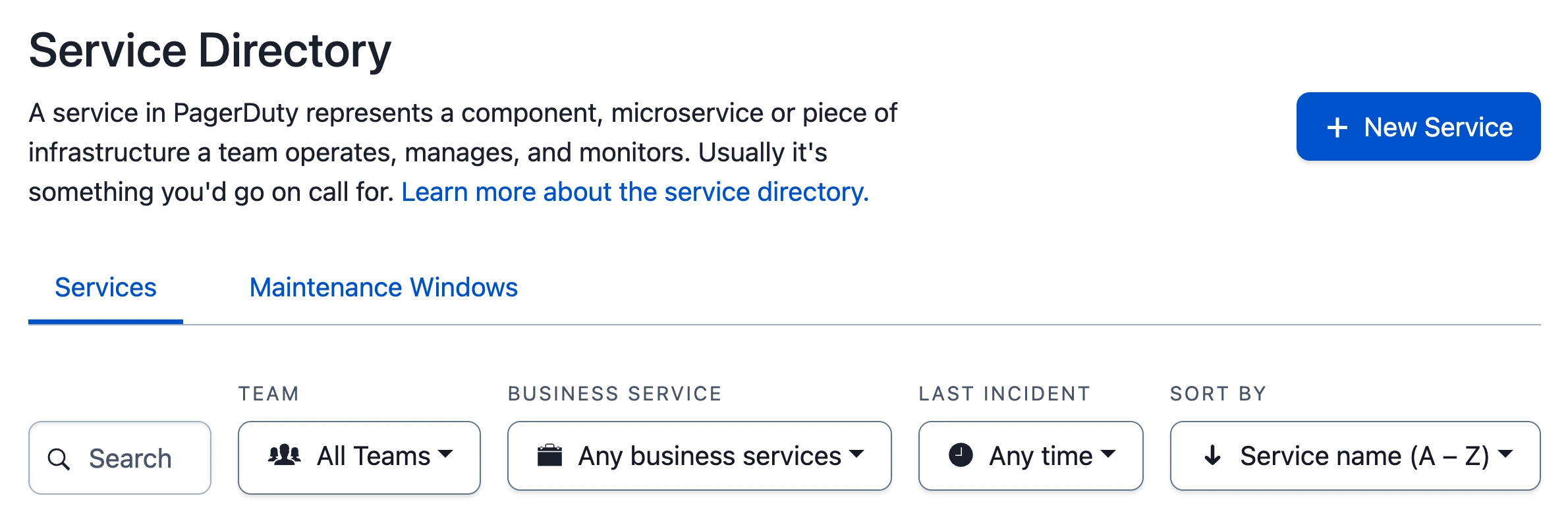
Search for services
Search by Integration Key
You can enter an integration key as a search term to return a list of services that have a matching key. To search by integration key, prepend your search with key:, i.e., key:INTEGRATION-KEY-HERE.
Filter and Sort
Refine your results by combining search queries, filters and sorting. You can use the following filters to narrow down search results:
- AIOps Service
- Team
- Business Service
- Last Incident
- Sort By
AIOps Service
AIOps Notes
This filter only appears if you disabled AIOps on any of your services. Otherwise, all services have AIOps enabled by default.
The AIOps Service filter allows you to filter for: AIOps services, Non-AIOps services or All services. Please see our AIOps Service Configuration article for more information.
Team
The Team filter defaults to all of your teams, but can easily be adjusted to include All Teams, No teams or a specific Team. If a service is not associated with a Team, it will not appear when a Team filter is active. Please note that this filter is only available to accounts with the Teams feature.
Business Service
The Business Service filter allows you to filter for the technical services associated with a specific Business Service. Please note that you will need to configure Business Services in order to return any results with this filter.
Last Incident
The Last Incident filter allows you to filter by services that have had a recent open incident. The options in the dropdown are Any time, Within 24 hours and Within 7 days.
Sort By
The Sort By dropdown further organizes your search results. When first visiting the page, this defaults to alphabetical order. Once you enter a search term, the sort will default to order by relevance. The sorting options are Service name (A-Z), Service name (Z-A), Oldest incident and Most recent incident.
Note: For the Most recent incident option, services that have never had an incident will be placed after all other services.
Maintenance Windows
You can review and manage Maintenance Windows in the Service Directory by selecting the Maintenance Windows tab. Read Maintenance Windows to learn more.
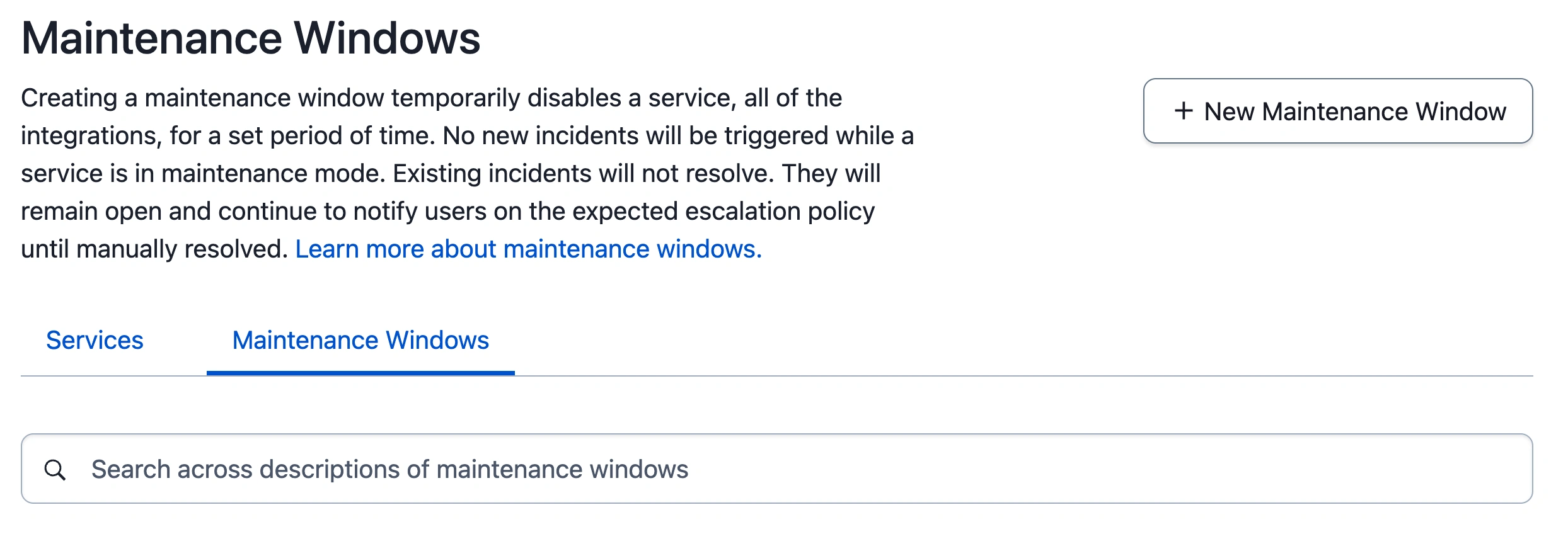
Maintenance Windows in the Service Directory
Service Standards
Organizations can use Service Standards to easily define, share and track service configuration criteria. This provides individual teams clear guidelines for setting up and managing their services in PagerDuty. Service Standards improve consistency and predictability during incident response, and they support enhanced analytics and better comparability among services and teams.
Required User Permissions
- Service Standards will only be viewable to Admins and the Account Owner by default. Admins and the Account Owner have the option to adjust settings to allow all users to view Service Standards.
- A user needs to have permissions to view a given service in order to view the Service Standards associated with it.
Configure Service Standards Settings
- In the PagerDuty web app, navigate to Services Service Directory and click Standards met to the right of any service.
- In the side panel that appears, click Settings in the top right.
- Optional: To edit who can view Service Standards, under Visibility, select Admins only, Everyone or No One.
- You may also edit settings for each standard under the [#] Active Standards section:
- To edit a standard's description: Click the icon, edit the description and then click Save.
- To edit the Service name matches [Regex] standard: Click the icon to the right of the title, enter your preferred Regex and then click Save.
- To edit which services the standard applies to: Click the link under Applies to (All Services or Some Services, depending on configuration). Under Apply standard to, select All Services or Selected Services.
- If you select Selected Services: Select is or is not from the dropdown to filter for matches or exclusions. Search and select your preferred service(s). Click Save.
- To disable a standard: Click the toggle to the right of the standard to the off position. If all standards are disabled, the Service Standards feature will be disabled for your account and will no longer be visible in the Service Directory or Service Profile.
- To re-enable a standard: Click the toggle to the right of the standard to the on position.
View Service Standards
Service Standards Score
The Service Standards score will be viewable for each service within the Service Directory and Service Profile. The initial benchmarks for services are based on PagerDuty’s best practices for service configuration. The score is presented as a ratio of how many standards have been met out of the total standards established.
- Service Directory: The Service Standards score is viewable on the right side of the services table within the Service Directory.
- Service Profile: The Service Standards score is viewable on the right of the Service Profile header.

Service Standards Score: Service Directory

Service Standards Score: Service Profile
Service Standards Panel
To view more details about each score, click Standards met to the right of the score. A right-side panel will display, which shows whether the service meets the Service Standards criteria. To view a description of the standard and why it matters, select the dropdown to the right of any of the individual standards. Under this dropdown, you can also click a contextual button to view guided help to remediate a Service Standard that has not met the criteria.
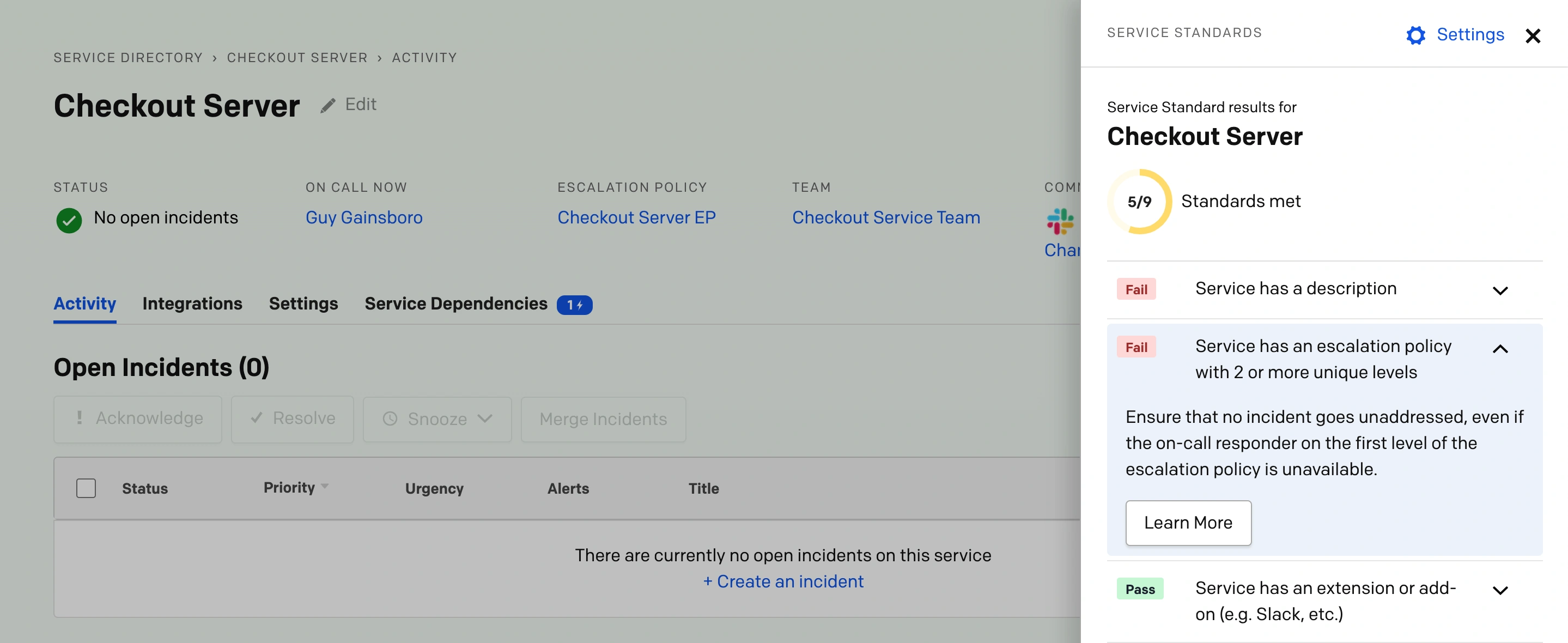
Service Standards Panel
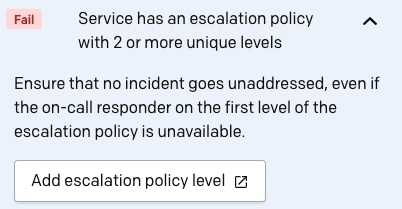
Service Standards Remediation Guidance
List Service Standards via API
If you would like to list all Service Standards within your account, please reference our API documentation.
Additional Service Directory Actions
Create a New Service
Users with appropriate permissions can click New Service in the top right to create a new service. For more info, please read Create a Service.
View Service Incidents
To view a service’s incidents, as well as information about the on-call rotation and upcoming maintenance windows, select More View Incidents to the right of a service’s listing.
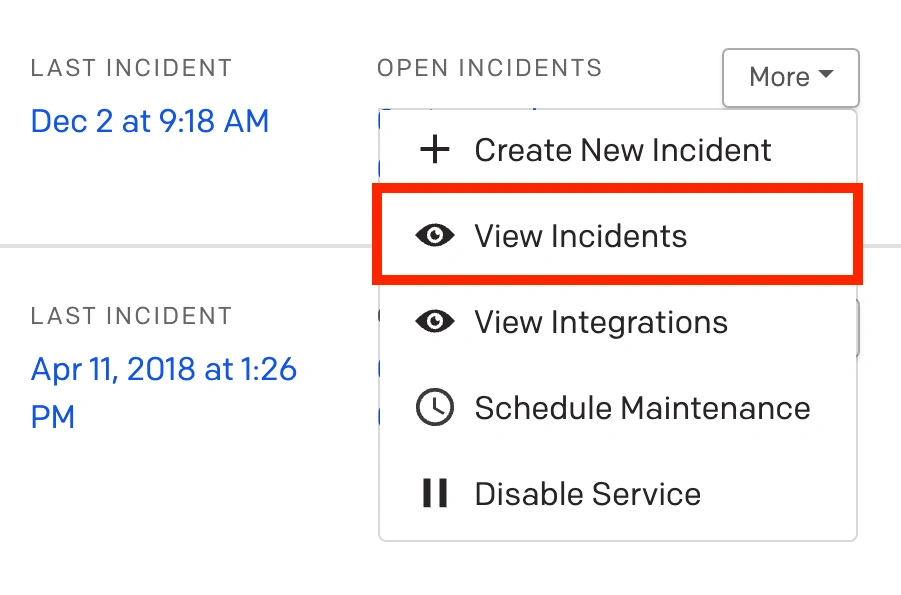
View Incidents
View Service Integrations
For quick access to integrations, users with appropriate permissions can use the shortcut More View Integrations to the right of a service’s listing.
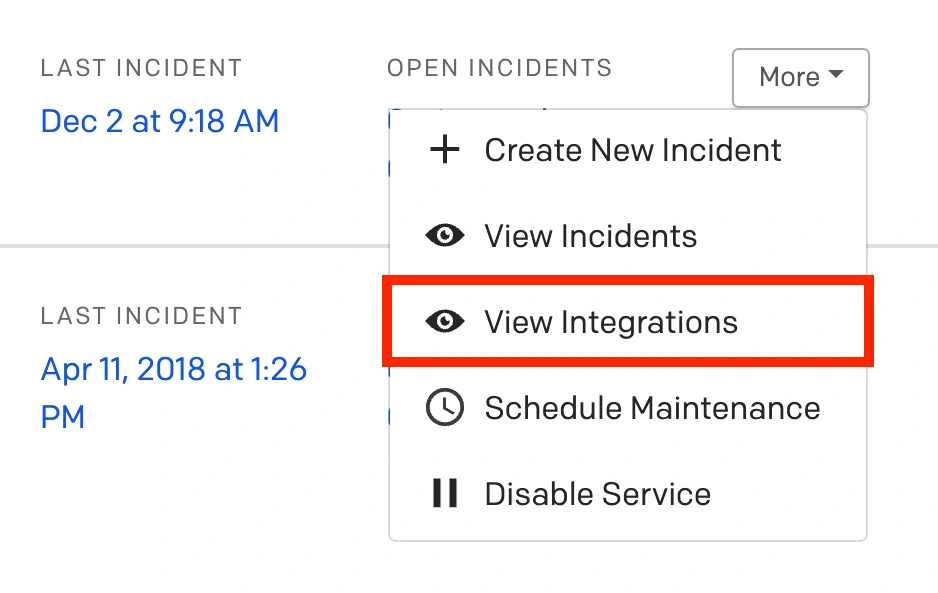
View Integrations
Dynamically-Built URL
As you enter search criteria and apply filters, query parameters are dynamically added to the URL in your browser’s address bar. This can be useful for adding bookmarks, sharing the link with others, or addressing the following questions:
- Which services owned by my Teams had incidents in the last week?
- How many of the services in my organization have the word “database” in them?
- Are there any services that have never had an incident and are currently unowned by a team? Should we delete those services from PagerDuty?
Updated 5 months ago
